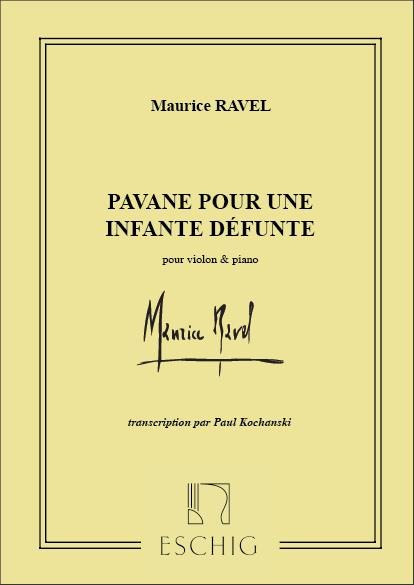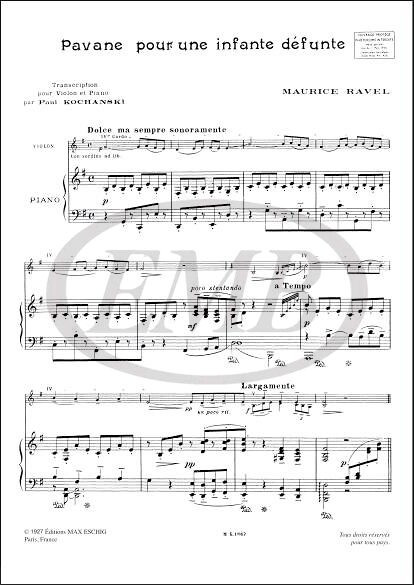Description
Maurice Ravel: Pavane pour une Infante Défunte for Violin and Piano
Product Information
- UPC: 9790045011734 / 979-0045011734
- Product Type: Violin and Piano Sheet Music
- Publisher: Max-Eschig
- Item Number: ME00186700
- Other Reference: ME00186700
Overview
Maurice Ravel’s “Pavane pour une Infante Défunte” (Pavane for a Dead Princess), originally composed for solo piano in 1899 and later orchestrated by the composer in 1910, is one of his most iconic and evocative works. The title conjures images of a gentle, ceremonial court dance imagined for a young princess of a bygone era. Ravel himself noted that the piece was not a lament for any specific person, but rather a poetic recreation of 17th-century courtly grace through a modern harmonic lens.
This arrangement for violin and piano, edited by the renowned violinist Paul Kochanski, preserves the delicate textures and haunting lyricism of the original, while allowing the violin to sing with a vocal-like, expressive quality. The piano part retains Ravel’s characteristic rich harmonic palette, providing a lush and shimmering backdrop for the solo voice. Marked by its slow tempo, graceful phrasing, and subtle dynamic inflections, the work demands a refined sense of tone and restraint from both performers. The melancholy elegance of the main theme, introduced tenderly by the violin, evokes a sense of dignified nostalgia, transporting listeners to an imagined, timeless realm of stillness and introspection. This version remains a favorite in recital settings, offering violinists the opportunity to explore French impressionist style, coloristic nuance, and emotive shaping. Kochanski’s transcription enhances the piece’s accessibility to a broader range of performers, while honoring the delicate spirit of Ravel’s original conception.
French Translation - Overview
La « Pavane pour une Infante Défunte » de Maurice Ravel, composée à l’origine pour piano seul en 1899 puis orchestrée par le compositeur lui-même en 1910, est l’une de ses œuvres les plus émouvantes et reconnaissables. Le titre, volontairement évocateur, ne désigne pas une personne réelle mais plutôt une évocation poétique d’une danse de cour ancienne, empreinte de noblesse et de mélancolie raffinée.
Dans cette transcription pour violon et piano, réalisée par le célèbre violoniste Paul Kochanski, l’esprit de la version originale est préservé avec subtilité et élégance. Le violon devient une voix chantante, presque humaine, qui porte la ligne mélodique avec tendresse et retenue, tandis que le piano restitue les harmonies riches et feutrées caractéristiques de l’univers sonore de Ravel. Avec son tempo lent, ses phrases longues et soignées, et ses nuances délicates, l’œuvre exige une grande maîtrise expressive et un jeu tout en finesse. Le thème principal, doucement introduit par le violon, déploie une nostalgie majestueuse, nous plongeant dans une atmosphère suspendue, à la fois intemporelle et intime. Souvent interprétée en récital, cette version permet aux violonistes d’explorer les subtilités du style impressionniste français, tout en mettant en valeur la plasticité sonore du violon et sa capacité à évoquer la voix humaine. La transcription de Kochanski rend cette œuvre emblématique accessible à de nouveaux interprètes, tout en restant fidèle à l’esprit rêveur et délicat imaginé par Ravel.
Product Features
- Format & Dimensions: Standard sheet music
- Instrumentation: Violin and Piano
- Difficulty Level: Intermediate, suitable for skilled performers
- Length: Approximately 24 pages
Interesting Facts
- Cultural Significance: Ravel's "Pavane" is infused with emotional depth and has become a staple in the classical repertoire, often performed in concert settings.
- Performance Popularity: The arrangement for violin and piano is particularly popular among chamber musicians and is frequently featured in recitals, appreciated for its expressive potential and technical demands.
- Legacy of Ravel: Maurice Ravel is celebrated as one of the leading composers of the early 20th century, known for his innovative orchestration and ability to convey complex emotions through music.
French Translation - Interesting Facts
- Importance culturelle : La « Pavane » de Ravel est empreinte d’une grande profondeur émotionnelle et est devenue une pièce incontournable du répertoire classique, souvent interprétée en concert.
- Popularité en interprétation : L’arrangement pour violon et piano est particulièrement prisé des musiciens de chambre et fréquemment présenté en récital, apprécié pour son potentiel expressif et ses exigences techniques.
- Héritage de Ravel : Maurice Ravel est reconnu comme l’un des compositeurs majeurs du début du XXe siècle, célèbre pour son orchestration novatrice et sa capacité à exprimer des émotions complexes à travers la musique.
Publishers
Published by Max-Eschig, a respected publisher in the field of classical music, dedicated to providing musicians with high-quality scores that enhance their performance experience.
We value your feedback! Share your experience with this product to help others make informed decisions. Your review is important to us!
Hashtags
#MauriceRavel #PavanePourUneInfanteDefunte #ViolinAndPiano #ClassicalMusic #MaxEschig

















